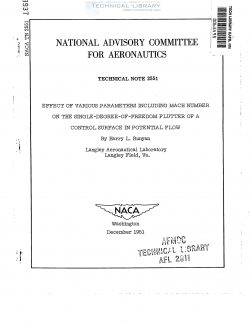naca-tn-2551
- Version
- 147 Downloads
- 920.37 KB File Size
- 1 File Count
- December 16, 2016 Create Date
- December 16, 2016 Last Updated
National Advisory Committee for Aeronautics, Technical Notes - Effect of Various Parameters Including Mach Number on the Single Degree of Freedom Flutter of a Control Surface in Potential Flow

Various investigations of single—degree-of-freedom pitching oscil-
lations of a wing in potential flow have been made. However, corre-
* sponding studies of single—degree-of- -freedom flutter of a control
' surface have not been made. The present paper demonstrates by theo—
i retical calculations that single- degree-of- -freedom control—surface
‘ flutter is possible. The effects of structural damping, aerodynamic
balance, axis of rotation, and compressibility are included.
The mechanism of instability presented here is based on potential-
flow theory and the results of such a study are not directly applicable
to separated flow; in addition, certain practical limitations are
discussed.
Flutter of a control surface alone, that is, an unstable oscilla-
tion in which the control surface is effectively rigid and nondeformable
and rotates around its hinge line, has been encountered on aircraft in
flight. This phenomenon, as well as stall flutter, is thought to be
associated with separated or nonpotential flow, although the explanation
is not entirely clear. Flutter of a control surface in one degree of
freedom is possible in potential flow, at least theoretically, and forms
the subject of the present paper. The development of this subject may
possibly contribute to the understanding of the nonpotential- flow
problem.
Theoretical investigations of several types of undamped single-
degree-of-freedom oscillations in potential flow have been reported
recently. For instance, Smilg (reference 1) has reported a study of
the undamped oscillations of a pitching wing in incompressible flow and
this study has been extended by Bunyan in reference 2 to include the
effect of compressibility. Cunningham (reference 3) has studied the
undamped bending oscillations of a swept wing in subsonic flow. The
undamped pitching oscillations of a wing in supersonic flow have been
studied by a number of investigators, for instance, Garrick and Rubinow
(reference h), Temple and Jahn (reference 5), and Watkins (reference 6).
The aforementioned papers concern single-degree-of-freedom pitching
of a wing or the bending of a swept wing. some examples of control-
surface flutter in one degree of freedom are given in reference 7 along
with a discussion of some possible causes. Apparently no calculation
studies exist demonstrating the conditions for the existence of single-
degree-of—freedom oscillations of a control surface. Accordingly, the
purposes of this paper are (l) to show the conditions for the existence
of single—degree-of-freedom oscillations of a control surface based on
potential—flow theory and (2) to examine and present the effect of various
parameters such as Mach number, fluid density (or altitude), location of
axis of rotation, structural damping, and aerodynamic balance on this type
of oscillatory instability.
| File | Action |
|---|---|
| naca-tn-2551 Effect of Various Parameters Including Mach Number on the Single Degree of Freedom Flutter of a Control Surface in.pdf | Download |

Comment On This Post